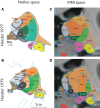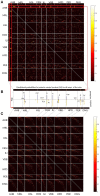Toward a Common Terminology for the Thalamus
- PMID: 30687023
- PMCID: PMC6336698
- DOI: 10.3389/fnana.2018.00114
Toward a Common Terminology for the Thalamus
Abstract
The wealth of competing parcellations with limited cross-correspondence between atlases of the human thalamus raises problems in a time when the usefulness of neuroanatomical methods is increasingly appreciated for modern computational analyses of the brain. An unequivocal nomenclature is, however, compulsory for the understanding of the organization of the thalamus. This situation cannot be improved by renewed discussion but with implementation of neuroinformatics tools. We adopted a new volumetric approach to characterize the significant subdivisions and determined the relationships between the parcellation schemes of nine most influential atlases of the human thalamus. The volumes of each atlas were 3d-reconstructed and spatially registered to the standard MNI/ICBM2009b reference volume of the Human Brain Atlas in the MNI (Montreal Neurological Institute) space (Mai and Majtanik, 2017). This normalization of the individual thalamus shapes allowed for the comparison of the nuclear regions delineated by the different authors. Quantitative cross-comparisons revealed the extent of predictability of territorial borders for 11 area clusters. In case of discordant parcellations we re-analyzed the underlying histological features and the original descriptions. The final scheme of the spatial organization provided the frame for the selected terms for the subdivisions of the human thalamus using on the (modified) terminology of the Federative International Programme for Anatomical Terminology (FIPAT). Waiving of exact individual definition of regional boundaries in favor of the statistical representation within the open MNI platform provides the common and objective (standardized) ground to achieve concordance between results from different sources (microscopy, imaging etc.).
Keywords: MNI standard space; concordance analysis; human; nomenclature; parcellation; terminology; thalamus.
Figures












Similar articles
-
Toward a Common Terminology for the Gyri and Sulci of the Human Cerebral Cortex.Front Neuroanat. 2018 Nov 19;12:93. doi: 10.3389/fnana.2018.00093. eCollection 2018. Front Neuroanat. 2018. PMID: 30510504 Free PMC article. Review.
-
Quantitative susceptibility atlas construction in Montreal Neurological Institute space: towards histological-consistent iron-rich deep brain nucleus subregion identification.Brain Struct Funct. 2023 Jun;228(5):1045-1067. doi: 10.1007/s00429-022-02547-1. Epub 2022 Aug 29. Brain Struct Funct. 2023. PMID: 36038737
-
Human Motor Thalamus Reconstructed in 3D from Continuous Sagittal Sections with Identified Subcortical Afferent Territories.eNeuro. 2018 Jul 4;5(3):ENEURO.0060-18.2018. doi: 10.1523/ENEURO.0060-18.2018. eCollection 2018 May-Jun. eNeuro. 2018. PMID: 30023427 Free PMC article.
-
An MRI based average macaque monkey stereotaxic atlas and space (MNI monkey space).Neuroimage. 2011 Apr 15;55(4):1435-42. doi: 10.1016/j.neuroimage.2011.01.040. Epub 2011 Jan 20. Neuroimage. 2011. PMID: 21256229
-
Mapping the primate thalamus: historical perspective and modern approaches for defining nuclei.Brain Struct Funct. 2023 Jun;228(5):1125-1151. doi: 10.1007/s00429-022-02598-4. Epub 2023 Jan 9. Brain Struct Funct. 2023. PMID: 36622414 Free PMC article. Review.
Cited by
-
Cerebello-thalamic activity drives an abnormal motor network into dystonic tremor.Neuroimage Clin. 2022;33:102919. doi: 10.1016/j.nicl.2021.102919. Epub 2021 Dec 16. Neuroimage Clin. 2022. PMID: 34929584 Free PMC article.
-
Disuse-driven plasticity in the human thalamus and putamen.Cell Rep. 2025 Apr 22;44(4):115570. doi: 10.1016/j.celrep.2025.115570. Epub 2025 Apr 11. Cell Rep. 2025. PMID: 40220292 Free PMC article.
-
Characterizing functional modules in the human thalamus: coactivation-based parcellation and systems-level functional decoding.Brain Struct Funct. 2023 Nov;228(8):1811-1834. doi: 10.1007/s00429-022-02603-w. Epub 2022 Dec 22. Brain Struct Funct. 2023. PMID: 36547707 Free PMC article. Review.
-
Study of gray matter atrophy pattern with subcortical ischemic vascular disease-vascular cognitive impairment no dementia based on structural magnetic resonance imaging.Front Aging Neurosci. 2023 Feb 6;15:1051177. doi: 10.3389/fnagi.2023.1051177. eCollection 2023. Front Aging Neurosci. 2023. PMID: 36815175 Free PMC article.
-
Small nuclei identification with a hemispherical brain PET.EJNMMI Phys. 2022 Oct 8;9(1):69. doi: 10.1186/s40658-022-00498-4. EJNMMI Phys. 2022. PMID: 36209191 Free PMC article.
References
-
- Albe-Fessard D., Guiot G., Lamarre Y., Arfel G. (1966). Activation of thalamocortical projections related to tremorogenic processes, in The Thalamus, eds Purpura D. P., Yahr M. D. (New York, NY: Columbia University Press; ), 237–253.
-
- Amunts K., Morosan P., Hilbig H., Zilles K. (2012). Auditory system, in The Human Nervous System, 3rd Edn, eds Mai J. K., Paxinos G. (San Diego, CA: Academic Press/Elsevier; ), 1270–1300. 10.1016/B978-0-12-374236-0.10036-7 - DOI
-
- Andrew J., Watkins E. S. (1969). A Stereotaxic Atlas of the Human Thalamus and Adjacent Structures: A Variability Study. Philadelphia, PA: Lippincott Williams & Wilkins.
-
- Anthoney T. R. (1994). Neuroanatomy and the Neurologic Exam: A Thesaurus of Synonyms, Similar Sounding Non-Synonyms and Terms of Variable Meaning. Boca Raton, FL: CRC Press.
Publication types
LinkOut - more resources
Full Text Sources

